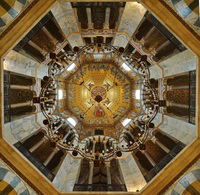The ground-state hyperfine structure (GS-HFS) of hydrogen is known from the hydrogen maser to relative precision of 10$^{–12}$. It is of great interest to measure the same quantity for its antimatter counterpart, antihydrogen, to test the fundamental CPT symmetry, which states that all particles and antiparticles have exactly equal or exactly opposite properties. Since CPT is strictly...
The Baryon Antibaryon Symmetry Experiment (BASE-CERN) at CERN’s antiproton decelerator facility conducts high-precision comparisons of the fundamental properties of protons and antiprotons, such as their charge-to-mass ratios, magnetic moments and lifetimes. These experiments provide sensitive tests of charge-parity-time (CPT) invariance in the baryon sector. BASE was approved in 2013 and has...
The effects of quark-sector Lorentz violation on deep inelastic electron-proton scattering are studied. We show that existing data can be used to establish first constraints on numerous coefficients for Lorentz violation in the quark sector at an estimated sensitivity of parts in a million. We calculate the expected bounds that can be extracted from existing HERA data and the reach of the...
Precision measurements of magnetically trapped antihydrogen provides a unique and pow-
erful way to test fundamental symmetries. A cornerstone of the standard model, CPT
symmetry demands that the spectrum of antihydrogen be identical to that of its ordinary
matter counterpart. Of particular interest is the 1S-2S transition which has been mea-
sured in hydrogen[1] with the remarkable relative...
In recent years, increasingly larger amounts of cold antihydrogen has been confined in the ALPHA magnetic trap [1] and has become available to perform precise measurements of its spectrum [2, 3]. Owing to this advancement, the Universality of Free Fall, a pillar of General Relativity, is put to test in a novel apparatus, named ALPHA-g, scheduled to take its first data in 2018. The ALPHA-g...
The KLOE-2 experiment continues and extends the program of its predecessor KLOE in the field of discrete symmetry tests with the K meson system, among other studies which comprise light meson spectroscopy, dark matter searches and $\gamma\gamma$ physics. Together, KLOE and KLOE-2 have recorded the largest sample (almost 8 fb$^{-1}$) of e+e- collisions at the energy equal to $\phi$ meson mass,...
